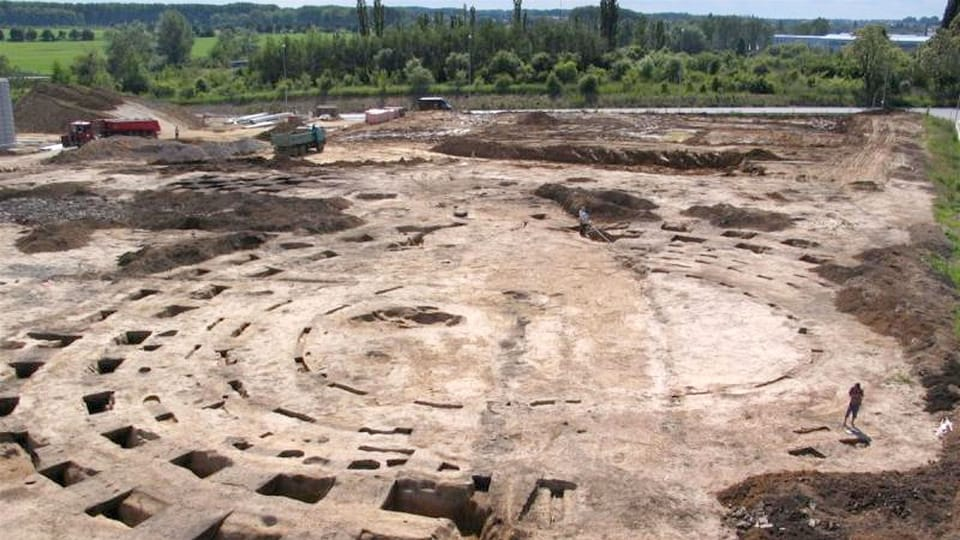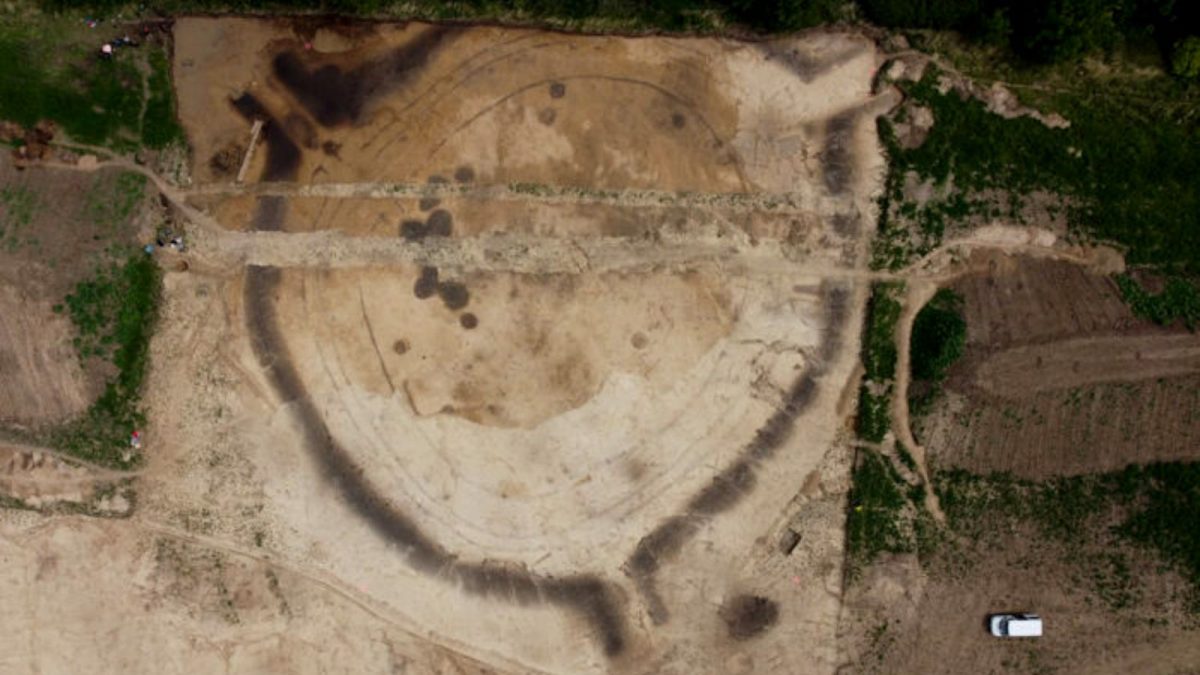Jan Bartek – AncientPages.com – In Vinoř, an area on the outskirts of Prague, Czech Republic, a mysterious 7,000-year-old circular structure has fascinated archaeologists for many years. Scientists have now released new photos of this Neolithic circular structure, and a new attempt is being made to solve this ancient mystery.

The first written mention of the village of Vinoř dates from the 11th century. However, people have lived here much longer. Credit: Institute of Archaeology of the Czech Academy of Sciences
Vinoř Is Older Than Stonehenge And The Egyptian Pyramids
“The roundel in Vinoř has a diameter of 55 m and is unusual in its layout, as it is one of the few with three entrances,” says Miroslav Kraus, the head of field research at the Institute of Archaeology of the CAS, Prague.
Artist’s impression of what the Neolithic structure may have looked like. Credit: Institute of Archaeology of the Czech Academy of Sciences
The ancient structure was discovered in the 1980s during the construction of utility networks, but it is only in recent years scientists have started investigating the Neolithic rondel. In September 2022, archaeologists announced the Vinoř roundel has an unusual floor plan with three entrances. It is estimated that about 90 percent of the total floor plan survived, which was unusual. “This is an extraordinary opportunity for archaeology,” Jaroslav Řídký from the Prague Institute of Archeology said. There are only 10 similar finds in Europe.
The extent of the fieldwork is also unique, and archaeologists will gradually uncover the structure almost in its entirety.
Despite being older than the Egyptian pyramids or England’s Stonehenge, the Vinoř rondel is still extremely well-preserved.
As previously reported on Ancient Pages, few people know about Central Europe’s ‘roundels,’ but these Neolithic circular enclosures have secrets to reveal.

Archaeologists are excavating at the site again with the goal of uncovering the structure’s secrets. Credit: Institute of Archaeology of the Czech Academy of Sciences
According to Rídký the so-called roundels are the oldest evidence of architecture in the whole of Europe. They are a series of circular ditches, and they are always arranged in a circle with two, three, four, or more entrances to the center, four being the most common. The circular ditches usually have a number between one and three, or rarely four.
The results indicate that it is a circular structure with a diameter of about 55 m, consisting of a single trench with a pointed bottom and three circular troughs in the area enclosed by the trench. There are three entrances to the center of the structure, emphasized by the trench extending outwards from the site – facing north, southwest, and southeast.
A Mystery From 7,000 Years Ago
The original form of the roundels has long been disputed. What is known, however, is that there was a beam construction inside, anchored in troughs and surrounded by one to a maximum of four trenches. There was probably a mound piled up with excavated material on the outside of the trench or trenches.
One of the most important questions remains unanswered. What was the Neolithic roundel used for? Several possibilities come into consideration – was it a building of a religious nature? Was it a cult center or was it used for more ordinary purposes, for example as a marketplace, sport field or area?
There were two, three, or most often four entrances (but exceptionally also five or six ones) leading into the center. “If two entrances are documented, they are located east and west of the center of the roundel, while in the case of four entrances, they are more or less directed towards the cardinal points,” explains Jaroslav Řídký.
According to radiocarbon-dated objects found in the trenches, all currently known roundels date from the period 4850-4700/4600 BC and have been documented in the environment of several archaeological cultures. They are, therefore, the oldest special (monumental) buildings in Europe.
The roundel in Vinoř is important because scientists are systematically researching almost its entire area, and it will thus be possible to take samples for dating and other natural science analyses from different parts of the original structure. We also know from previous rescue excavations that a settlement has been inhabited for at least 300-400 years, located to the northeast of the roundel. We know of other similarly dated settlements within a five-kilometer radius.
The so-called roundel, built around 7,000 years ago, is located in the district of Vinoř on the outskirts of Prague. Credit: Archaeological Institute of the Academy of Sciences
Despite these findings, it is still unclear what purpose these structures have served, says Miroslav Kraus, who is in charge of the research.
One theory is that it could have been used as an economic center, a center of trade. It could also have been a center of some religious cult, where rites of passage or rituals connected to the time of year were performed.
New Attempt To Unravel The Purpose Of The Neolithic Circular Structure
Archaeologists are now conducting new excavations to learn more about the puzzling Vinoř structure. Currently, the Neolithic structure raises more questions than answers.
“It resembles the world-famous English monument Stonehenge, but it is 1,500 years older. What was the prehistoric roundel on the edge of the village of Vinor used for? Could it have performed religious functions, or was it perhaps the daily meeting place of our ancient ancestors? Who and why built this circular structure?
These and other questions should be answered by the research conducted by the Prague Institute of Archeology of the Academy of Sciences of the Czech Republic. Experts have a unique opportunity to explore the site almost entirely,” the science team informs in a press statement.
See also: More Archaeology News
Dolmen de Soto, a Neolithic stone circle with a diameter of 65 built for unknown purposes, has been documented in Spain. Could a Neolithic connection exist between the mysterious Vinoř structure and Dolmen de Soto?
Written by Jan Bartek – AncientPages.com Staff Writer





